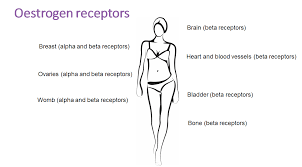It´s important that you understand a little about oestrogen receptors before we move onto specific topics around this transition in life, to have a true understanding of why receptors and binding of hormones is so important.
There are at least 37 symptoms associated with menopause and there is not one single organ in the body that doesn´t have oestrogen receptors. So when they hormone levels decline, this has an impact upon all organs.
The move into our POST REPRODUCTIVE YEARS is so much more than a loss of periods or tackling hot flashes. Menopause is the PERMANENT loss of OVARIAN oestrogen and progesterone, which can have profound effects throughout a woman´s body. We may be able to produce small amounts by the adrenals (if stress isn´t affecting production)
Oestrogen has more than 400 functions in the body!
First thing to remind ourselves is that we have 3 types of oestrogen.
1.Oestrone (E1): Considered to exert a fairly weak effect.
2. Oestradiol (E2): Considered to exert the most potent effect of all oestrogens. Levels decline post menopause.
3. Oestriol (E3): Predominant during pregnancy where it is produced by the placenta.
In PRE-MENOPAUSE, the 17 beta oestradiol E2 is the main circulating oestrogen mainly produced by the ovaries. Hormones typically have a 28 day cycle (lunar cycle). Low oestradiol (E2) is more ”uncommon” in younger females, but still experienced especially if a females fat body mass is below normal (usually below 14%).
A low oestradiol level is much more common in late perimenopause-postmenopausal women or in women of any age who have had their ovaries surgically removed (oophorectomy) and/or those who have not been treated with hormone replacement.
In the MENOPAUSAL TRANSITION hormone production is more erratic and may cause more fluctuations such as hot flushes, sleep issues, increased anxiety, mood swings etc which may appear from 40´s onwards.
In MENOPAUSE the E2 oestradial is now primarily produce in smaller quantities in the breast, brain, muscles, bone and fat tissue and acts more locally. E1 (oestrone) is the oestrogen produced after menopause produced from adipose (fat) tissue via another hormone called DHEA.
SUMMARY: THERE IS A SIGNIFICANT DECREASE IN SYSTEMIC OESTRADIOL AND PROGESTERONE LEVELS:
Oestrogens regulate multiple functions across the body but they have to BIND to cell RECEPTORS to perform their function. So changes in amounts and receptors can impact our health, especially around menopause.
Due to the reduction of hormones, women have increased risk of the following once passed menopause:
- Anxiety/Depression
- Poor Cognitive Function
- Acid Reflux and Digestive Imbalances
- Autoimmune Disease
- Osteoporosis
- Joint Pain
- Cardiovascular Disease
- Weight Gain
- Migraines
- Poor Sleep Quality
Oestrogens plays such important roles in stimulating growth of the reproductive tissues, maintaining healthy bones, increasing the levels of neurotransmitters in the brain, and helping keep the cardiovascular system healthy.
As a reminder, symptoms and conditions commonly associated with oestrogen deficiency include hot flashes, night sweats, sleep disturbances, foggy thinking, vaginal dryness/painful intercourse, incontinence, urinary tract infections, depression/anxiety, thinning skin, bone loss, joint pain, weight gain and heart palpitations.
There are many dietary and supplemental changes you can do to try to support oestrogen levels, but since we are all individual it´s about finding out what helps YOU.
The foods having weak oestrogenic effects that may help support your transition are phytoestrogens and examples are within the E book.
We will take a look at many symptoms that we may experience and how we may best be able to manage them during the programme.


